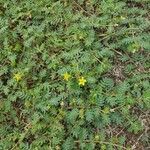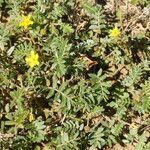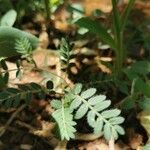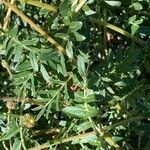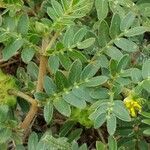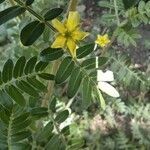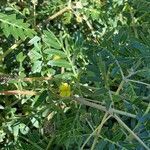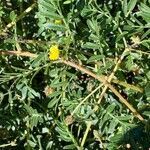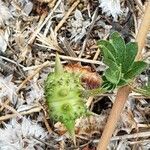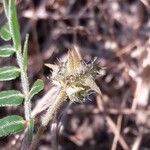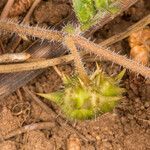Prostrate, subglabrous, more rarely villous, herb; stems 20–100 cm long. Leaves in unequal pairs, with 4–7 pairs of leaflets; leaflets narrowly elliptic, 5–12 mm long, 1–5 mm wide, oblique at base, acuminate, acute or rounded, subglabrous or sparsely villous adaxially, moderately to densely villous abaxially, ±concolorous. Flowering pedicel 5–15 mm long, upright. Sepals 3–6.5 mm long, glabrous or pubescent adaxially, pubescent abaxially except sometimes for glabrous hyaline margin. Petals obovate, 4–12 mm long. Intrastaminal glands distinct. Stamens 10; filaments 3–4 mm long. Ovary densely white-strigose; style 0–0.3 mm long and stigma 0.9–1.3 mm long, or style 0.6–1.3 mm long and stigma 0.6–1.5 mm long. Fruit to 8 mm high, 8–12 mm wide, dissociating into 5 (rarely fewer) cocci; fruiting pedicel 10–20 mm long. Cocci woody, subglabrous or sparsely strigose, sometimes above a shorter erect and dense pubescence dorsally, and with pair of lateral, widely diverging, medial spines 3–8 mm long, shorter downward pointing basal pair and shorter spines or tubercles between.
Herbs, annual; herbage hairy (whitish), especially young shoots, becoming glabrate. Stems prostrate, green to reddish, to 1 m, ± hirsute, sericeous. Leaves 2–4.5 × 1 cm; stipules 1–5 × to 1 mm; leaflets 6–12(–16), ovate to elliptic, largest 4–11 × 2–4 mm, densely sericeous, younger parts silvery, becoming glabrate. Pedicels shorter to longer than shorter pair of leaves, in flower 2–7 mm, in fruit 5–15 mm, apex bent. Flowers 5(–10) mm diam.; sepals ovate-lanceolate, 2–4 × 1.5–2 mm, minutely ciliate, hirsute; petals oblong, 2.5–5 × 1–3 mm; outer whorl of nectary glands yellowish, inner whorl distinct, yellow, triangular, 0.2 mm; stamen filaments 2–3 mm; anthers yellow, cordate, 1 mm; ovary 1–5 mm diam.; style 5-ridged, cylindric, stout, 1–1.5 mm; stigma globose. Schizocarps (7–)10–15 mm diam. excluding 4–12 mm spines; mericarps bearing 2 conic spreading 3–7 mm dorsal spines and sometimes 2 smaller retrorse spines near base, body green to gray or yellowish, hispid, strigose, or glabrate.
Annual ± pubescent, villous or hispid herb; branches prostrate, up to 90 cm. long; internodes up to 6 cm. long, 2-3 mm. in diameter.. Leaves 3-6 cm. long; leaflets 5-8 pairs, oblong to lanceolate, 4-8 × 1.5-5 mm.; stipules linear to lanceolate, up to 8 mm. long.. Flower medium-sized, up to 15 mm. across; pedicel 5-10 mm. long, shorter than the subtending leaf.. Sepals linear-lanceolate, 3-6 × 1-2 mm., deciduous.. Petals lemon-yellow to orange-yellow, 4-8 × 3-6 mm.. Stamens 8-10 in 2 whorls; filaments up to 3 mm. long; anthers 0.5-1 mm. long.. Ovary globular, 1 mm. across; style very short or absent; stigma pyramidal, 0.8-1.2 mm. long.. Fruit disc-shaped; stalk ± 1 cm. long; mericarp 4-5 × 2-3 mm., provided with 2 pairs of spines.
Annual herb, pubescent; branches procumbent, spreading. Leaves opposite; members of a pair unequal in size; paripinnate; leaflets in 5-10 pairs, one of each pair longer than the other, sessile, oblong to ovate, margins entire; stipules 2. Flowers axillary, solitary, subtended by smaller leaf. Calyx of 5 semi-persistent sepals; narrowly ovate, hairy outside. Petals 5, ± ovate, 3-12 mm long, yellow. Stamens 10, in 2 whorls; intrastaminal glands 10, free; anthers oblong-cordate. Flowering time Sept.-Mar. Fruit 5-angled, splitting at length into 5 indehiscent mericarps; mericarps with 2 lateral divergent acute spines and 2 shorter spines directed downwards.
Herbs, annual, prostrate, glabrous, pubescent, or hispid. Branches 20-60 cm. Leaves opposite, even-pinnate, 1.5-5 cm, with 6-16 leaflets; leaflet blades oblong to obliquely oblong, 5-10 × 2-5 mm, base slightly oblique, margin entire, apex acute to obtuse. Flower ca. 1 cm in diam. Pedicel shorter than leaves. Sepals persistent. Stamens inserted on base of disk, with scale-form appendages. Ovary 5-angled, 5-locular, with 3 or 4 ovules per locule; stigma 5-parted. Schizocarp 4-6 mm, hard, pubescent or glabrous, with 5 carpels with 2 hardened 4-6 mm spines at mid margin, surface spiny or prickly. Fl. May-Aug, fr. Jun-Sep. 2n = 24, 30, 36, 48.
Annual; stems hirsute, branched from the base, forming mats to 1 m wide; lvs short-petioled, 2–6 cm, one of each pair distinctly the larger; lfls usually 6–8 pairs, oblong, 5–15 mm; peduncles 5–10 mm; fls 8–10 mm wide; intrastaminal glands distinct, not forming a ring; body of the fr 1 cm thick, each segment with 2 stout divergent spines and a longitudinal row of tubercles; 2n=12, 24, 26, 48. Native of the Mediterranean region, well established as a roadside weed in w. U.S., and occasionally found in our range.
A slender herb. It is an annual plant. It grows 30-60 cm tall. It creeps along the ground. The stems are hairy. The leaves are compound. They are divided along the stalk into several leaflets. There is no end leaflet. The flowers are yellow and often folded. They are small and have 5 petals. The fruit are round with sharp thorns. It becomes woody and breaks into 5 wedge shaped sections when ripe. There can be 2-5 seeds in each section. The spines are very sharp and strong.
Spreading, prostrate, usually decumbent, annual herb. Leaves pinnate, usually unequal with 1 of a pair shorter than the other. Petals 3-12 mm long. Intrastaminal glands free. Fruit at length breaking up into 5 cocci. Cocci usually with 2 lateral divergent acute spines inserted above middle and 2 shorter spines directed and inserted near base of coccus. Flowers yellow.
Annual herb. Branches spreading, procumbent or decumbent. Leaves pinnate, usually unequal with 1 of a pair shorter than other. Flowers: intrastaminal glands free; petals 3-12 mm long, yellow; Sep.-Mar. Fruit schizocarp; mericarps with 2 lateral divergent acute spines inserted above middle, and 2 shorter spines directed downwards and inserted near base of mericarp.
Leaves unequal, the larger up to 6 cm. long (usually somewhat smaller) with up to 8 pairs of leaflets; the smaller up to 3·5 cm. long (usually much smaller) with up to 6 pairs of leaflets; leaflets 4–15 × 1·5–7 mm., rather oblique, oblong, oblong-lanceolate or lanceolate-ovate, acute or subobtuse, villous on both surfaces or nearly glabrous.
Glabrescent or hairy, prostrate annual, with stems radiating from a crown, up to 2 m long. Leaves opposite, unequal, pinnate, leaflets oblong, silky. Flowers solitary in axils, intrastaminal glands free, yellow. Fruit fragmenting into 5 segments, each with several sharp conical spines.
Annual herb, extremely variable in habit, with spreading prostrate and usually decumbent branches, ± pubescent, villous or hispid, sometimes glabrescent in all vegetative parts; branches up to 2 m. long, sometimes woody at the base.
Glabrescent or hairy, prostrate annual with stems radiating from a crown. Leaves opposite, unequal, pinnate, leaflets oblong, silky. Flowers solitary in axils, yellow. Fruits spiny, fragmenting into segments.
Fruit breaking up into 5 cocci, each with 2 ± strong divergent spines in the upper and 2 smaller ones in the lower part, usually crested on the back, tuberculate and strigose.
Petals light yellow, 3–8 (12) mm. long, broadly cuneate, usually shorter than or as long as or sometimes up to 2·3 times the length of the sepals.
Style very short; stigma 0·8–1·2 mm. long, hemispheric, mostly asymmetric and nearly sessile on the ovary.
Peduncle usually shorter than, or as long as the subtending leaf.
Sepals 3–6 mm. long, linear-lanceolate, usually villous outside.
Stipules up to 10 mm. long, linear or linear-lanceolate, acute.
Filaments about 3 mm. long; anthers 0·5–1 (1·2) mm. long.
A trailing herb, woody below, from pubescent to tomentose
Ovary with stiff bulbous-based hairs.
Intrastaminal glands not connate.
